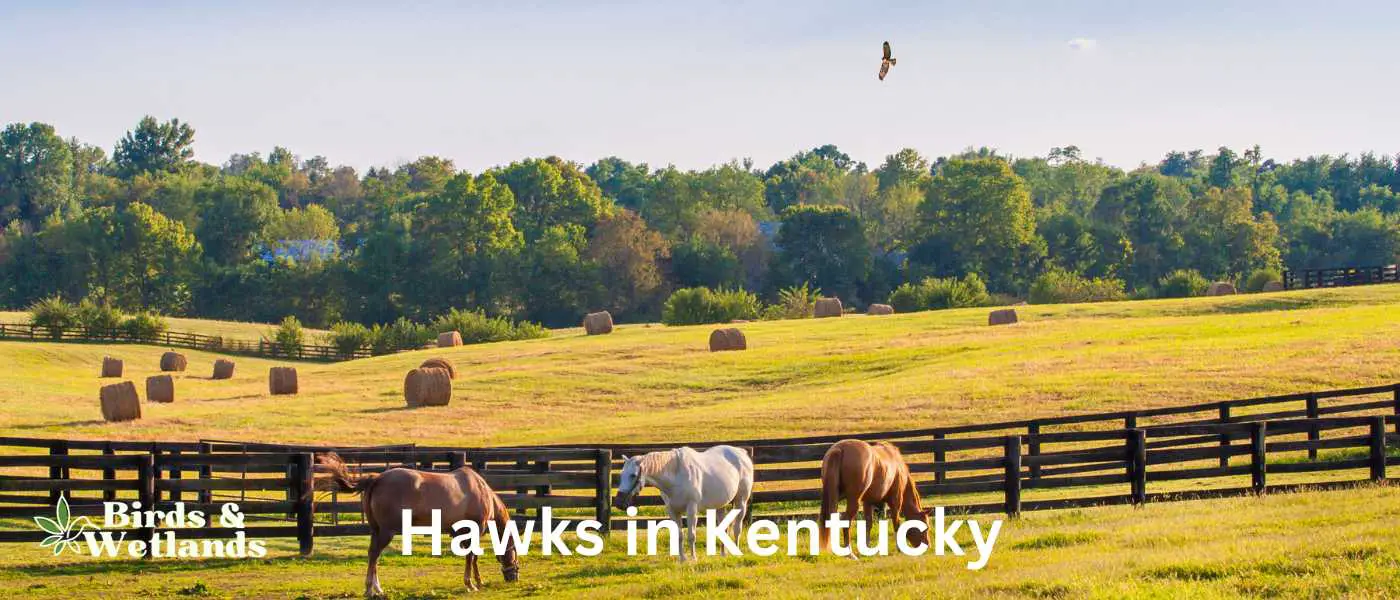Kentucky, a state rich in natural beauty and diverse ecosystems, serves as a home for a multitude of wildlife species. Among its many inhabitants, one particular group of birds of prey in Kentucky captures attention – the hawks. This state’s unique geography, from the Appalachian Mountains to the Mississippi River, offers an ideal habitat for these magnificent birds of prey.
Types of Hawks in Kentucky
Red-Tailed Hawks: As the most common hawk in North America, you can spot Red-Tailed Hawks perched high in the trees around the Cumberland Gap National Historical Park.
Cooper’s Hawks: Often mistaken for the similar-looking Sharp-shinned Hawk, the Cooper’s Hawk can be seen in suburban areas like Lexington and Louisville.
Red-Shouldered Hawks: With a preference for woodlands, the Red-Shouldered Hawk frequents the Daniel Boone National Forest, making their nests in tall trees near water bodies.
Northern Harrier: These hawks love open grasslands and can often be seen gliding low over the fields in the Land Between The Lakes National Recreation Area.
Sharp-Shinned Hawks: This agile bird hunter can be spotted swooping between trees in the diverse landscapes of Mammoth Cave National Park.
Broad-Winged Hawks: During migration season, crowds gather in Bernheim Arboretum and Research Forest to witness the spectacle of Broad-Winged Hawks soaring in the sky.
Rough-Legged Hawks: A winter visitor to Kentucky, the Rough-Legged Hawks can be spotted in the Barren River Lake State Resort Park during the colder months.
Ferruginous Hawks: While rare in Kentucky, keen-eyed birdwatchers might be lucky enough to spot a Ferruginous Hawks in the open spaces around the Kentucky Downs.
Kentucky Hawks Photo Guide
Red-tailed Hawk (Buteo jamaicensis)
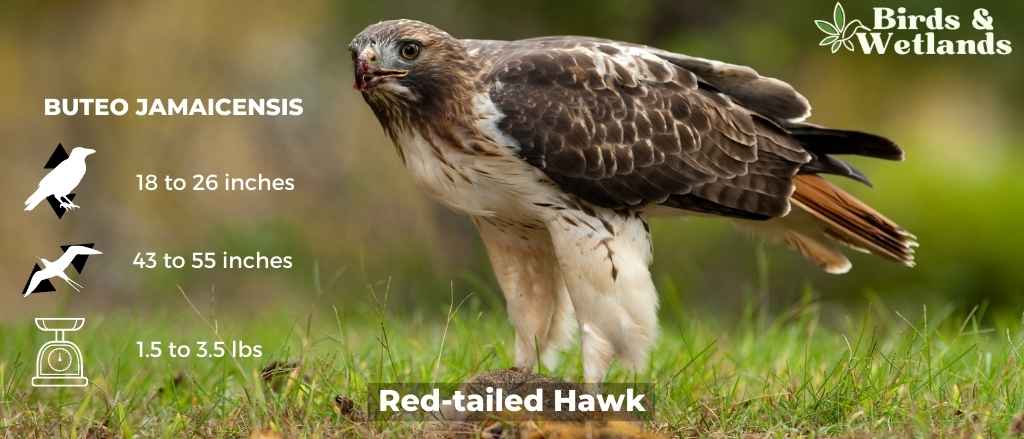
The Red-tailed Hawk is a large bird of prey that is commonly found across North America. This species is part of the genus Buteo, which is often referred to as the “true hawks,” and includes more than two dozen species of raptors.
Red-tailed Hawks have a robust size, ranging from 18 to 26 inches in length and sporting a wingspan that can exceed 4 feet. They have a broad, rounded set of wings and a short, wide red tail. This species is most easily recognized by its rich, rust-colored tail, which gives it its common name. However, juvenile hawks might not yet have this distinctive feature.
Their feathers are generally dark brown on their dorsal side (back) with a lighter, often speckled, ventral side (front). The intensity and pattern of their plumage can vary significantly based on their age and geographic location, as there are about 14 recognized subspecies of Red-tailed Hawks.
As for their diet, Red-tailed Hawks are carnivores and have a broad diet that includes rodents, ground rabbits, reptiles, and other birds. They are skilled hunters that typically sit on high perches and use their keen eyesight to spot potential prey. Once they have identified a target, they swoop down to capture it with their powerful talons.
Red-tailed Hawks mate for life and build nests high off the ground, often in tall trees or on cliff edges. Their nests are made of sticks and can be quite large. They typically lay 1-3 eggs per year, which are incubated by both parents.
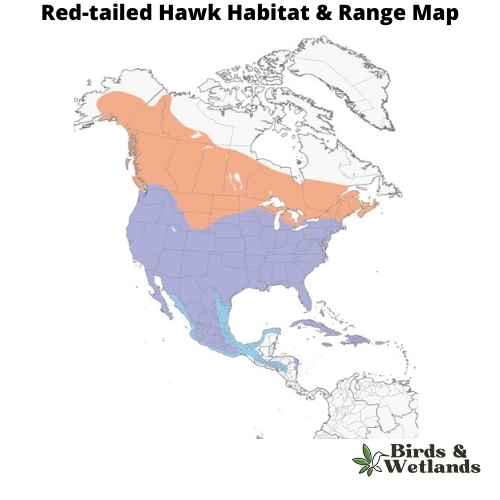
Red-tailed Hawk Sound
Cooper’s Hawk (Accipiter cooperii)

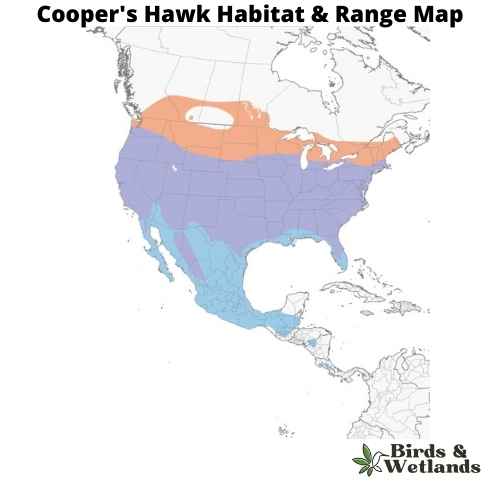
Listen:
The Cooper’s Hawk is a medium-sized bird of prey native to North America. Known for its agility and speed, it is part of the Accipitridae hawk species, which also includes other hawks, eagles, and kites.
Cooper’s Hawks are typically about 14 to 20 inches in length, with a wingspan ranging from 27 to 36 inches. They are known for their distinctive long, rounded tails and short, rounded wings. They have a steely blue gray top, with rusty bars on their underparts and thick, dark bands on their tails.
The Cooper’s Hawk is a skilled predator, primarily hunting birds and small mammals. They are adept at hunting in both dense forests and open areas, often catching prey mid-air in high-speed pursuits. They have also been known to visit the backyard bird feeder, not for the seed, but to prey on the smaller birds that gather there.
Cooper’s Hawks often build nests in dense tree canopies where they are well concealed. The female usually lays 3 to 5 eggs, and both parents share incubation duties. The young hawks fledge after about a month but will stay close to the nest, relying on their parents for food as they learn to hunt.
Red-shouldered Hawk (Buteo lineatus)
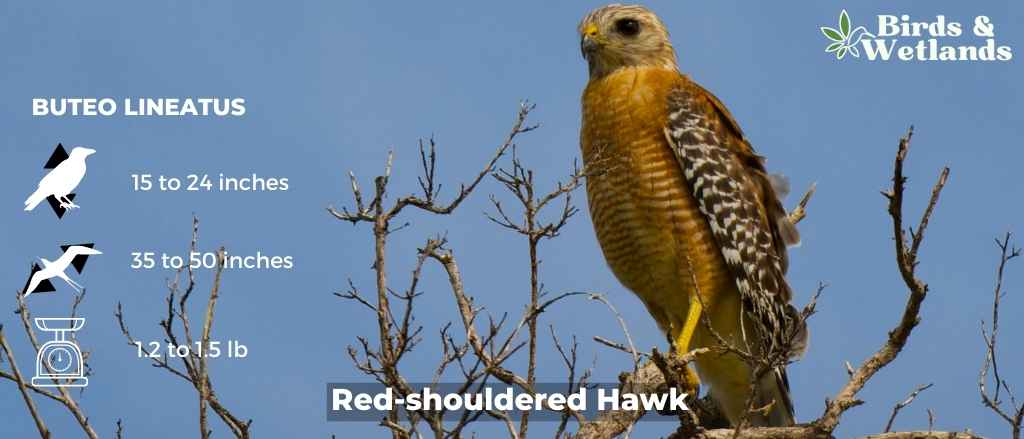
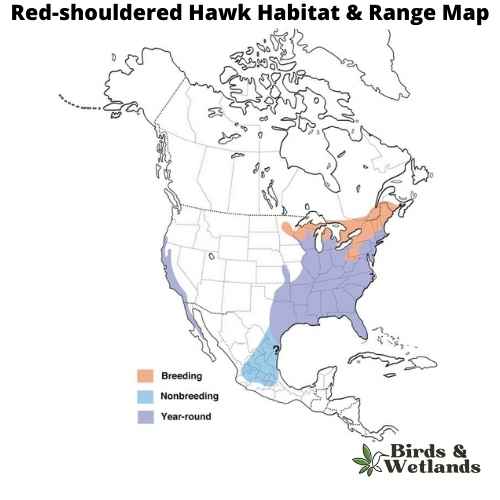
Listen:
The red-shouldered hawk are medium sized birds of prey, part of the buteo hawks family. It can be distinguished from other hawks by its reddish iris and pale legs.
The adult has rusty red upperparts, white underparts, a black chin and throat, and a reddish brown stripe over each eye, reddish brown heads and a strongly banded tail. The tail is reddish brown with two paler bands across it and they have white checkered wings. Juveniles are brown with dark barring and have pale fringes on the feathers of their wings.
Red-shouldered hawks nest in trees, though they also inhabit manmade structures including barns, bridges, and buildings. They prefer wooded areas with an open canopy but will use other places as well for nesting such as shrubs and hedges if needed.
The red-shouldered hawk’s diet – they eat small mammals such as ground squirrels, rabbits, voles, mice and rats. They also eat birds such as quail, pigeons and doves; reptiles including snakes; amphibians; fish; crustaceans; insects; and carrion (dead animals).
Northern Harrier (Circus hudsonius)
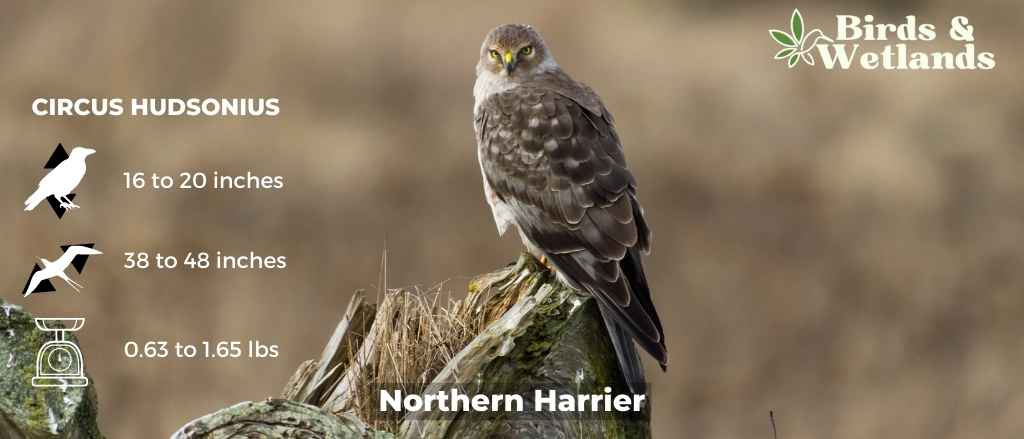
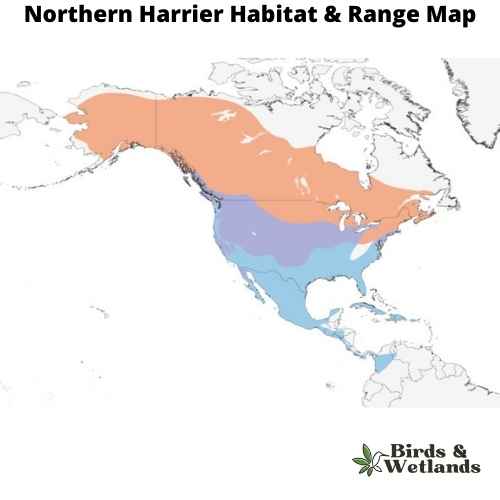
Listen:
The Northern Harrier is a medium-sized, slender hawk.
Adult birds are gray above, with pale bars on the wing feathers and white markings on the underwings and a white rump patch. The breast is barred with black and white, and the belly is streaked with brown.
They prefer open areas, such as grasslands and marshes, but can be found in almost any open habitat except dense woods.
Northern Harriers are opportunistic hunters that feed on small mammals such as mice, voles and rabbits as well as birds including quail, grouse and ducks. They hunt by flying low over open spaces such as fields or marshes.
Northern harrier nests on the ground in lowlands or hillsides near water bodies. It lays two to four eggs which hatch after 24 days of incubation by both parents. The chicks fledge after 30 days of hatching and remain dependent on their parents for another three weeks during which they learn how to fly.
Sharp-shinned Hawk (Accipiter striatus)
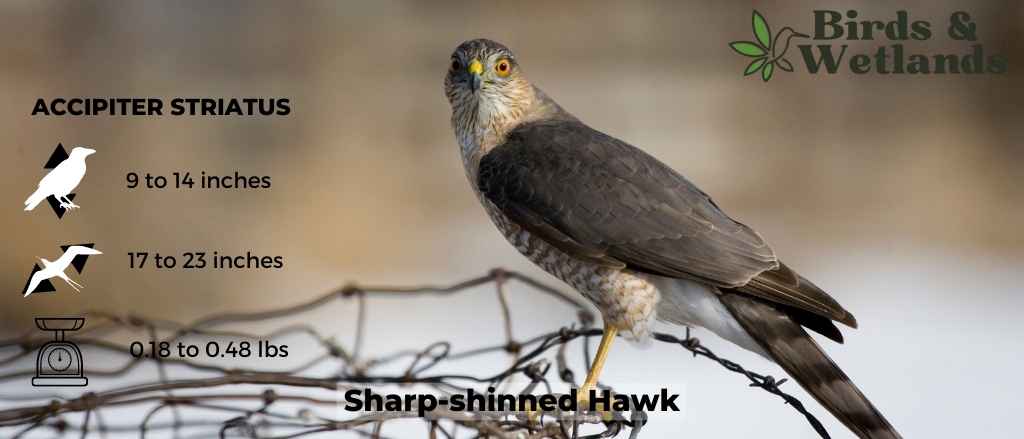
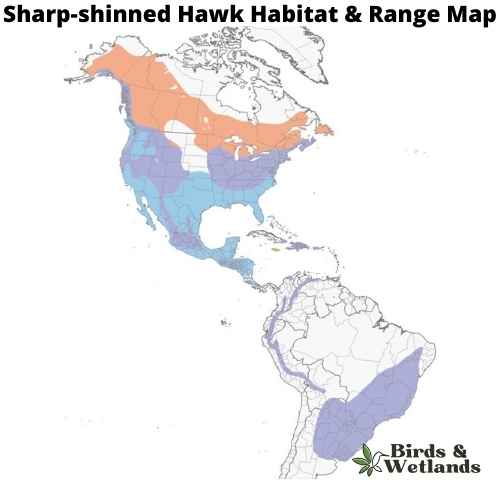
Listen:
The adult bird is brown on top and white underneath, with a dark brown band across its chest. It has short, rounded wings and a long tail that makes it look larger than it actually is. Adult sharp shinned hawks have black eyes, which are surrounded by white feathers. The female Sharp-shinned Hawk is browner than the male, who has darker brown markings on his back.
Sharp-shinned Hawks prefer open country for their habitat, including fields and meadows where they can hunt for mice and other small animals. They can be found throughout the United States but are most common in the east.
Sharp-shinned Hawks eat mostly small birds, such as sparrows and warblers, as well as small mammals such as mice and gophers. They catch prey by surprise using their incredible speed and agility, diving out of the sky at speeds up to 200 mph.
Sharp-shinned Hawks have an unusual hunting style for hawks—they prefer to catch their prey from perches above trees or telephone wires, rather than swooping down from above like most other hawks do and can often be seen hunting near bird feeders.
Broad-winged Hawk (Buteo platypterus)
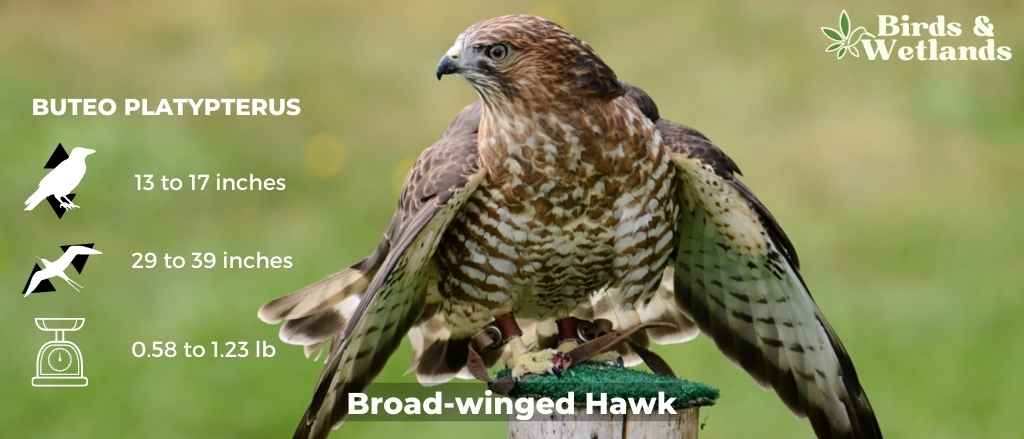
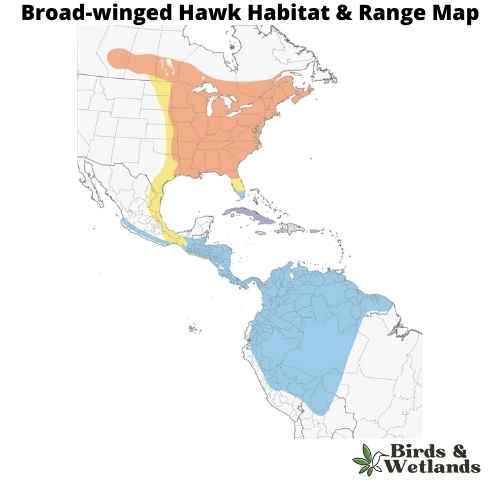
Broad-winged Hawk Sound
The Broad-winged Hawk holds a commanding presence as one of the largest hawks in the world, known for its broad wings. Its formidable size is a testament to its prowess as a bird of prey, effortlessly navigating the open skies in search of food.
Their distinctive appearance sets them apart. The adults exhibit a striking black and white pattern, complemented by a rusty breast and buff underparts and brown wings. In contrast, juveniles are adorned with a brown plumage, marked by pale edges on their feathers, adding to their distinctive youthful charm.
These hawks are most commonly found in open areas, such as farmlands or grasslands interspersed with scattered trees, which provide optimal conditions for when hawks hunt.
When it comes to their diet, Broad-winged Hawks feed on small rodents like mice, rats, squirrels, rabbits, and voles. Broad winged hawks breed during the spring and summer months then migrate to central and south America.
Rough-legged Hawk (Buteo lagopus)
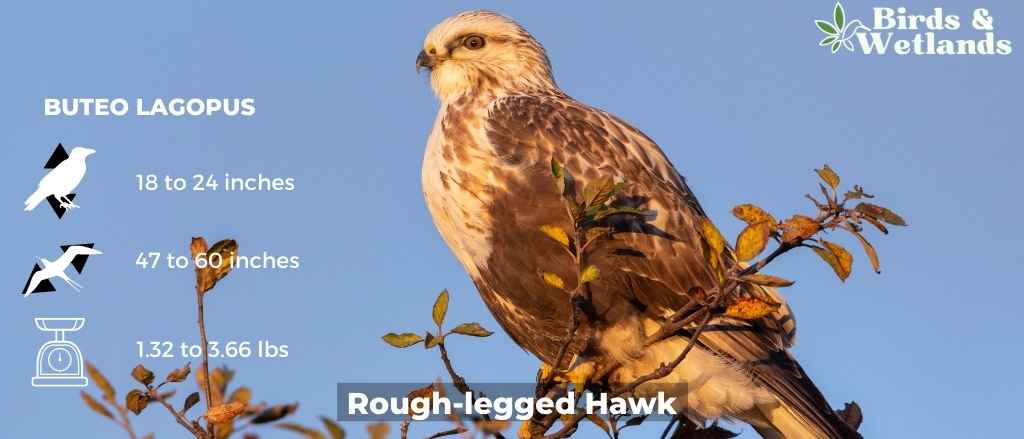
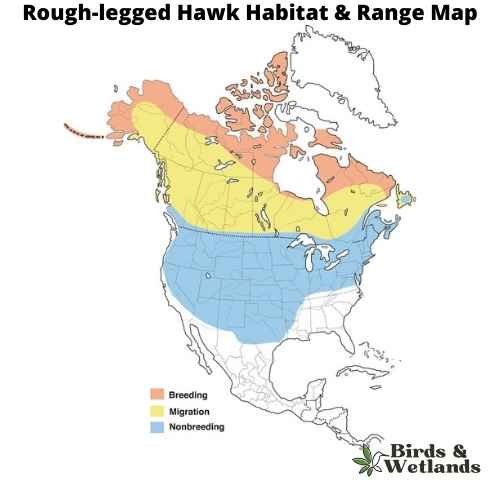
Rough-legged Hawk Sound
The Rough-legged Hawk is a large, raptor that is native to North America. It is also known as the American Rough-legged Hawk. Scientific Name: Buteo lagopus
The Rough-legged Hawk is a medium-sized hawk with a distinctive appearance, with dark brown feathers on its back and light brown feathers on its underside and broad thin wings. The hawk’s legs are also covered in dark feathers, which help to distinguish it from other species of hawk. The tail is barred with black and white. They have yellow eyes and dark feet.
Rough-legged Hawks hunt from above ground level, swooping down to catch its prey in its talons. When hunting for food, they prefer to eat small mammals such as squirrels and rabbits but will also eat birds if there aren’t any small mammals available. Although they eat a variety of small animals including birds, rodents, bats and reptiles, they rely heavily on fish for food during breeding season because it provides them with protein and calcium needed to produce eggs.
Ferruginous Hawk (Buteo regalis)
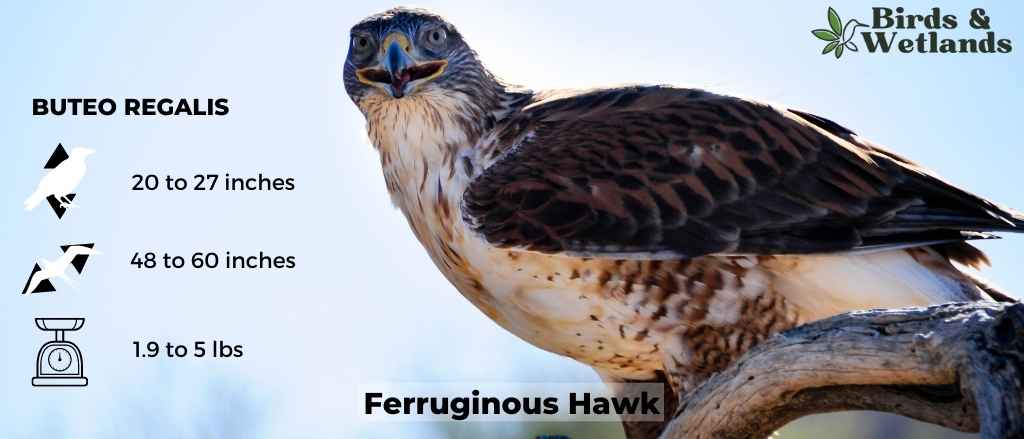
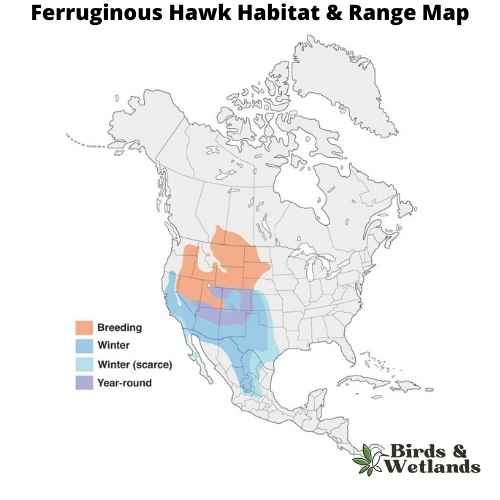
Ferruginous Hawk Sound
Scientific Name: Buteo regalis
Length: 20 to 27 in
Wingspan: 48 to 60 in
Weight: 32.0 to 80.0 oz
The Ferruginous Hawkis the largest hawk species native to North America. Known for its distinctive coloration and impressive size, this bird of prey predominantly inhabits the open landscapes of the western United States and parts of Canada.
Ferruginous Hawks are notable for their “ferruginous” or rust-colored back and shoulders, which contrasts sharply with the bird’s white underside. The hawk also has broad, rounded wings and a large, gape-mouthed beak. Ferruginous hawks exhibit dark morph and light morphs. Dark morphs have dark brown plumage, while light morphs display lighter, reddish-brown plumage. Morphs vary geographically.
Primarily feeding on small to medium sized mammals like rabbits and prairie dogs, the Ferruginous Hawk is an agile hunter, often seen soaring high above the ground or perched prominently while scanning for prey. It occasionally feeds on birds, reptiles, and insects as well.
Nesting for Ferruginous Hawks typically occurs on cliffs, hillsides, or large trees. The female lays between 2 to 5 eggs, and both parents share in the incubation and rearing of the chicks. The Ferruginous Hawk is a relatively solitary bird outside of the breeding season, and its call is a loud, high-pitched scream, often heard during courtship or near the nest.
Where to Spot Hawks in Kentucky
Land Between The Lakes National Recreation Area: This large inland peninsula offers a diverse range of habitats attracting a variety of hawks, including Red-tailed Hawks and Northern Harriers.
Cumberland Gap National Historical Park: Located at the intersection of Kentucky, Tennessee, and Virginia, this park is a great location for spotting Broad-winged Hawks during their migration period.
Daniel Boone National Forest: This extensive forest is home to various hawk species, including the Red-shouldered Hawks and Cooper’s Hawks.
Bernheim Arboretum and Research Forest: A hotspot for hawk migration, particularly for Broad-winged Hawks in the fall.
Barren River Lake State Resort Park: This park, with its mix of open water, wetlands, and woodlands, is a great winter spot for Rough-legged Hawks.
Kentucky’s rich avian biodiversity offers ample opportunities for hawk-watching. It’s geographical location, bordered by several states, presents unique opportunities for bird enthusiasts to experience the rich diversity of hawk species in the region.
| Neighbouring State’s Hawks | Hawk Watching Site |
|---|---|
| Hawks in Indiana | Indiana Dunes State Park |
| Hawks in Illinois | Illinois Beach State Park |
| Hawks in Missouri | Rockwoods Reservation |
| Hawks in Tennessee | Radnor Lake State Park |
| Hawks in Virginia | Rockfish Gap Hawk Watch |
| Hawks in West Virginia | Hanging Rock Raptor Observatory |
| Hawks in Ohio | Lake Erie Hawk Watch at Magee Marsh Wildlife Area |

